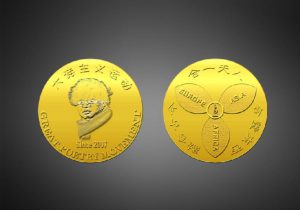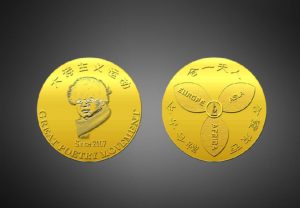大诗主义运动勋章简介

大诗主义运动勋章
(Great Poetry Movement Medal)由大诗主义运动委员会于2023年设立,每年将选择2名对大诗和史诗做出重要贡献的国际诗人颁发。2023年度的勋章颁发给了土耳其诗人纽都然·杜门(Nurduran Duman)和荷马国际诗歌节主席哈鲁克·萨辛(Haluk Sahin)。
大诗主义勋章由纯银打造,直径70mm,厚3.4mm,重70克,从设计到铸造都出自名家之手,肖像由著名摄影家宋醉发拍摄,勋章由著名雕塑家张国梁设计,印章由著名书法家古明川雕刻;正面是大诗主义运动发起人曹谁肖像,中英文书写:大诗主义运动(GREAT POETRY MOVEMENT);背面是古老的亚洲、欧洲、非洲三叶草地图,发布标注英文ASIA,EUROPE, AFRICA,地图由德国地理学家海因里希•宾廷(Heinrich Bünting)在1581年绘制,代表着当时已知的古老世界,在这里象征人类的共同家园,周围雕刻大诗主义运动的核心观点“融合古今,合璧东西,合一天人”。大诗主义运动从2007年曹谁写作《大诗主义运动宣言》开始,如今已经传播到世界各主要语种。
大诗主义是汉语诗坛在21世纪的一个诗歌潮流,大诗可以追溯到史诗,上世纪80年代由诗人海子提出,2007年诗人曹谁写作《大诗主义宣言》,跟西原、西棣等诗人共同发起大诗主义运动。主张从各个文明中提取元素,合一天人,合璧东西,融合古今,创造一个全新的意象世界。他们创办有民刊《大诗刊·文学视角》,被列为中国先锋诗派二十家之一,许多余编著的《笔尖上的舞蹈:80后文学见证》(原名《80后文学史》)在“文学理论”卷中有专章介绍,跟状态主义和性感写作一起被称为80后发起的三大文学思潮。代表诗人先后有庄苓、邯冰、雷迅、神家、深雪、夜陌、树贤、鹰子、苏明、月剑、彭书锦、张厚生、殷子虚、许言木、郭良忠、山宇扬、诺布朗杰等众多80后和90后诗人。在2018-2020年曹谁代表“大诗主义”跟伊沙的“后口语诗派”进行了三年的论战,被诗坛称为“曹伊之争”,曹谁在《文学自由谈》2023年第1期以封面人物撰文《曹伊之争与中国文坛的十大弊病》总结:“曹伊之争”在胡适写作《尝试集》后一百年爆发,大概是一系列因素促成的,当时许多人解读为“中国新诗百年道路之争”,认为是中国诗坛“盘峰论争”(1998年中国诗歌史上著名的知识分子流派和民间诗派的论战)以来最大的论争,“21世纪最现代化的论战”。这场论战的核心是中国新诗的走向问题,是伊沙倡导的“后口语诗”,还是曹谁倡导的“大诗主义”,抑或是其他的写作方法。而在这个过程中他却看清文坛的种种怪现状,文学呼唤一次深入的“文学改良运动”。从2017年随着曹谁加入世界诗歌运动,大诗主义运动逐步传播到世界各国。
Introduction to the Great Poetry Movement Medal

The Great Poetry Movement Medal was established by the Poetry Movement Committee in 2023 and is awarded annually by two international poets who have made significant contributions to great poetry and epic. The medal of 2023 was awarded to Turkish poet Nurduran Duman and Haluk Sahin, chairman of Homer International Poetry Festival.
The Great Poetry Medal is made of pure silver, with a diameter of 70mm, a thickness of 3.4mm, a weight of 70g, and made in Yongxing, the silver capital of China. From design to casting, it was created by famous artists. The portrait was taken by the famous photographer Song Zuifa, the medal was designed by the famous sculptor Zhang Guoliang, and the seal was carved by the famous calligrapher Gu Mingchuan; On the front is a portrait of Cao Shui, the initiator of the Great Poetry Movement, written in both Chinese and English: GREAT POETRY MOVEMENT; On the back is an ancient map of Asia, Europe, and Africa in clover’s shape, annotated with ASIA, EUROPE, and AFRICA in English. The map was drawn by German geographer Heinrich B ü ting in 1581 and represents the known ancient world at that time. Here, it symbolizes the common home of humanity, and the core idea of the Great Poetic Movement is carved around it, which is “integrating ancient and modern cultures, integrating Western and Eastern cultures, integrating sacred and secular cultures”. The Great Poetry Movement began in 2007 when Cao Shui wrote the “Manifesto of the Great Poetry Movement” and has now spread to major languages around the world.
Great Poeticism or Great Poetry Movement is a poetic trend in the Chinese poetry world in the 21st century. Great poetry can be traced back to epic poetry. It was proposed by Chinese poet Hai Zi in the 1980s, and in 2007, poet Cao Shui wrote the “Manifesto of Great Poeticism” and jointly launched the Great Poetry Movement with poets such as Xi Yuan and Xi Di. They advocats the extraction of elements from various civilizations, integrating sacred and secular cultures, integrating Eastern and Western cultures, integrating ancient and modern cultures, to creat a brand new world of imagery. He founded the magazine “Grand Poetry-Literary Perspective”. Great Poetry Movement was listed as one of the 20 avant-garde poetic schools in China. In “Dancing on the Pen Tip: A Witness to the Literature of the 80s” (formerly known as “History of Literature of the 80s”) edited by Xu Duoyu, have been introduced in a special chapter in the “Literary Theory” volume. Along with Statism and Sensory Writing, they are known as the three major literary trends initiated by the post-80s Chinese writers. Representative poets include Zhuang Ling, Han Bing, Lei Xun, Shen Jia, Shen Xue, Ye Mo, Shu Xian, Ying Zi, Su Ming, Yue Jian, Peng Shujin, Yin Zixu, Xu Yanmu, Guo Liangzhong, Shan Yuyang, Nuobu Langjie and many other post-80s and post-90s poets. In 2018-2020, Cao Shui, who represented the “Great Poetry Movement” and Yi Sha’s “Post-Colloquial Poetry School”, engaged in a three-year debate, which was referred to as the “Cao-Yi Dispute” in the poetry world. In the first issue of “Literary Freedom Talk” in 2023, Cao Shui, who wrote an article titled “Cao-Yi Dispute and the Ten Major Disadvantages of the Chinese Literary World” in the form of a cover poet, summarized that the “Cao-Yi Dispute” erupted one hundred years after Hu Shi wrote the “Trial Collection”,which is the first poetry collection published in mordern Chinese, which was probably caused by a series of factors, At that time, many people interpreted it as the “debate over the century long path of Chinese new poetry”, believing it to be the biggest controversy in the Chinese poetry world since the “Panfeng Dspute”(The Debate between Intellectuals Poets and Folk Poets in Chinese History) and the “most modern controversy of the 21st century”. The core of this debate is the issue of the direction of Chinese new poetry, whether it is the “Post-Colloquial Poetry” advocated by Yi Sha, the “Great Poetry” advocated by Cao Shu. During this process, He was able to discern the various strange current situations in the literary world, and literature called for an in-depth “literary reform movement”. Since 2017, With Cao Shui joining the World Poetry Movement, it has been spread to various countries around the world.
(曹谁)

新西兰 澳纽网出品
编辑:小图

广告 | Advertisement
在澳纽网做广告 | Advertise with us
593 views



